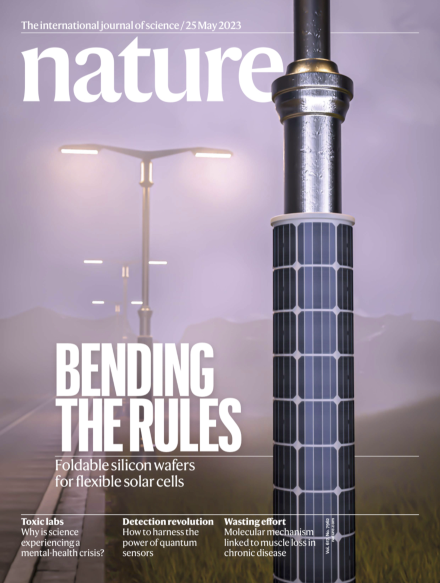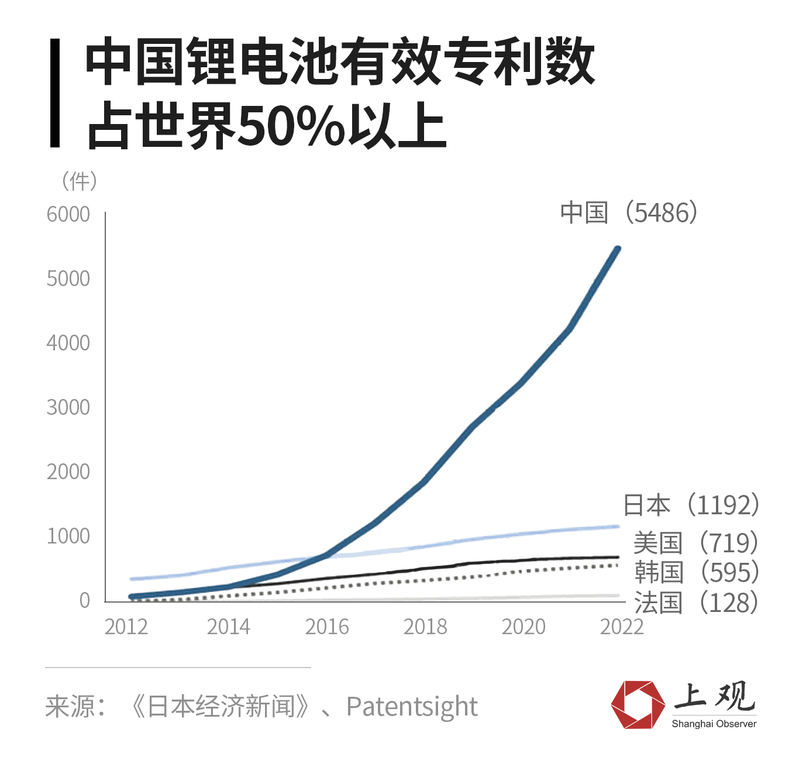But innovation needs to be driven more by physical industries, and scientific research certainly needs to "look up at the stars"
On May 25th, the journal Nature published a cover paper titled "Curling Rules: Flexible Silicon Chips for Flexible Solar Cells.".
The author of this paper is from the Shanghai Institute of Microsystems, Chinese Academy of Sciences. At a laboratory located in Jiading District, Shanghai Microsystems Institute, researchers bent and rolled a single crystal silicon solar cell as thin as paper, unfolded it, repeatedly bent and rolled it, and then unfolded it again. This solar cell is intact as before, without any breakage.
Seems ordinary? The pun on paper title "Curling Rules" in Nature magazine highlights the groundbreaking value behind it. The curling rule refers to the object of discussion in the paper - a curlable solar cell; Another layer of meaning is the scientific value contained in this type of battery - monocrystalline silicon was originally brittle, brittle, and difficult to bend, but the latest research results have changed long-standing norms.
People familiar with the solar cell industry are not surprised that this major breakthrough has occurred in China. Liu Wenzhu, the first author of the paper "Curling Rules" and associate researcher at the Shanghai Institute of Microsystems, said, "88% of global solar cells are produced in China. It is precisely because China has a complete solar cell industry platform that our scientific research is supported."
This is a supplement to the traditional concept of industry research relationship. As is well known, industrial development cannot be separated from scientific research. Scientific research can bring innovation, improve labor productivity, and promote industrial development. So, from large countries to small enterprises, scientific research is highly valued. But the development history of solar cells reveals a fact in reverse: scientific research cannot do without the support of modern industrial systems.
Not only solar cells, but journalists have interviewed industries and academic research fields such as automobiles, artificial intelligence, robotics, biomedicine, mathematics, materials, etc. in Shanghai, constantly hearing voices such as "industrial demand is an indispensable driving force for scientific research" and "science and technology only progress when they find a market.".
Industry is the "question setter" of scientific research
In fact, flexible solar cells are not a new idea. In a 1967 issue of Nature magazine, a short article was published exploring the possibility of flexible solar cells.

At the beginning of this article, it is said: "In the past year, the interest in solar energy in the British and American aerospace industry has gradually increased." In the United States, interest comes from Mars and Jupiter exploration programs; In the UK, scientists hope to change the orbit of spacecraft through electric propulsion devices. These tasks all pose a demand for flexible new solar cells.
This is the industry's call for scientific research. Not surprisingly, the call was initially made by Britain and America. The world's first solar cell was born in 1954 at Bell Laboratories in the United States. In the 1960s, artificial satellites launched by the United States had already utilized solar cells as a source of energy. As the British and American aviation industry further develops, thick and rigid solar cells can no longer meet the demand, and they need to become lightweight and flexible. The demand comes from the UK and the US, and scientific research naturally comes from the UK and the US.
More than half a century later, when Nature magazine published another article on flexible solar cells, the author became a Chinese scientist. At present, China is the leader in the global solar cell industry, accounting for 88% of production, 44% of newly installed capacity, and 42% of patent applications. In this country where solar energy production, application, and research and development rank first in the world, it is natural for local scientists to follow the "curling rules".
Liu Zhengxin, the corresponding author of "Curling Rules" and a researcher at the Shanghai Institute of Microsystems, said, "Industry and scientific research complement each other. Only when the industry develops can there be funding and demand to invest in research. Especially in my profession, if it cannot be linked to the industry or serve the industry, there is no value."
Researchers such as Liu Zhengxin often see examples of industry transfer leading to a decline in scientific research when looking at their foreign counterparts. At a top research institution in Germany, funding for solar cell research is becoming increasingly difficult to apply for, and even partners are difficult to find. Because Germany lacks a huge solar energy industry like China, both companies and the country are unwilling to continue investing in this research field.
The modern industry is the "setter" of scientific research, and this principle is the same in various fields. At the Shanghai Materials Research Institute, Dr. Yang Qi is developing a stainless steel with excellent thermal stability and strength. This research stems from the practical needs of domestic CNC machine tool manufacturing. In Zhangjiang Pharmaceutical Valley, biopharmaceutical companies are researching how to slow down T cell depletion. Yao Shuyuan, CEO of Annuo Linglu, said, "If it weren't for CAR-T therapy, there wouldn't be this research demand. Many things are like this, first discovering the demand in actual production, and then innovating and solving problems through scientific research."
"Some disciplines require 'looking up at the stars' based on curiosity, challenging human intelligence, and not necessarily seeing immediate applications," said Jin Shi, Dean of the Institute of Natural Sciences at Shanghai Jiao Tong University and Co Director of the Shanghai National Center for Applied Mathematics. "However, many disciplines are related to industries because the demands of industries drive their development." For example, in recent years, the discipline of applied mathematics has developed rapidly due to new demands from artificial intelligence, image recognition, data compression, and other fields. "Mathematics existed in ancient Greece and is very ancient. However, the constant demand from industries has given rise to new branches of mathematics, so it is always young," said Jinshi.
Practice is the "polishing tool" of theory

Industry not only demands scientific research, but also continuously corrects and refines theories through practice, ultimately leading to innovation.
When it comes to innovation, the following images flash in people's minds: designers wearing T-shirts sipping Starbucks, entrepreneurs in their twenties and thirties sketching their imaginative ideas on napkins after lunch; A game table is placed in the bright and transparent corner of the studio... but Harvard Business School professor Pisano asserts, "These are not innovations. Innovation is not a discovery, inspiration, or prototype in the laboratory, but a process of applying a new idea or concept to the market."
Chen Qi, Chairman of Kunyi Electronics, has a firsthand experience in promoting innovation in modern industrial systems. Kunyi Electronics, located in Fengxian District, Shanghai, is an automotive development tool supplier. Four years ago, they received an order from a large domestic enterprise to customize a car development and testing product. But because this customer is being sanctioned by the United States, they must replace the imported Serenius FPGA chip with domestically produced chips. At that time, when two domestic chips were added together, their performance barely caught up with one imported chip.
What matters more is not performance, but price. At that time, the unit price of domestic chips was 10 times that of imported chips. A mature industry is not only a matter of whether its technology meets standards, but also a matter of cost. From an industrial perspective, such domestically produced chips are useless.
Only four years later, Chen Qi discovered gratifying changes. Currently, there are at least two domestic companies, Ziguang and Anlu, whose FPGA chip performance is close to the level of Serenius, and more importantly, their prices have also been reduced to the same level. Because China has a wide range of chip application scenarios, the United States has implemented a chip blockade on China in recent years. Chinese companies have invested against the trend, filled gaps, and accelerated applications.
"The results are iterated through practice. Research is not just about sitting at home thinking that something is good, it's really good. Various problems will arise in practice and need to be solved through product iteration." Chen Qi said, "Pure theoretical research without engineering practice will never produce products. Without products, innovation cannot be achieved." When it comes to chips, the public is mostly concerned about advanced technologies such as 7nm, 4nm, and 3nm, but few people have noticed that the research and manufacturing of mature process chips in China in recent years has changed.
In the Lingang Nanqiao Science and Technology City of Fengxian District, where Kunyi Electronics is located, electric vehicle testing vehicles with various brand logos come and go every day. In between, data is increasing, algorithms are iterating, industries are advancing, and Shanghai's technological innovation capabilities are gradually strengthening.
History has repeatedly proven that when a country or city loses its industry, it will also lose its innovation capability. Taking lithium batteries as an example, they were initially developed by British and American physicists and chemists in the 1970s and 1980s. After the technology matured, they were transferred to Japan for manufacturing, and later production capacity gradually shifted to China. At the same time as the circulation of the lithium battery industry, related research and innovation are also circulating, with Japan first and then China replacing the United States as the innovation center in the lithium battery field. According to the statistics of Nihon Keizai Shimbun, in the past decade, China ranked first in the number of lithium battery related patents, accounting for more than half of the world. In addition, in the field of sodium ion battery research, which is considered a potential alternative to lithium batteries, China's number of patents and the number of citations of papers are significantly ahead of Japan and the United States.

Abandoning today's industry will lock you out of tomorrow's industry gate. Former Intel CEO Grove once commented on the development history of the lithium-ion battery industry in the United States: 30 years ago, when the United States stopped producing consumer electronics products, it lost its leading position in the battery industry, then missed out on personal computer batteries, and now lags far behind in electric vehicle batteries. In recent years, countries such as the United States and Japan have actively promoted the manufacturing of chips, lithium batteries, and other products in their own countries. This is not only to ensure supply chain security, but also to compete for the leading position in research and innovation, in order to win future industries.
On the cover of the issue of Nature magazine where the article "Curling Rules" was published, a flexible solar panel wrapped around the lamp post of a street lamp, emitting orange light to illuminate the night sky. In 1967, when British scientists envisioned the future of flexible solar cells, they may not have thought that their applications would go beyond space and penetrate into all aspects of human daily life. They may also not have imagined that more than half a century later, the research and manufacturing center for this product will be in distant China.




